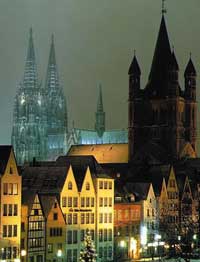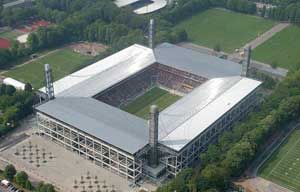FIFA World Cup Host Cities - COLOGNE
Cologne city profile
| Population: |
1,000,000 |
| Federal State: |
Nordrhein-Westfalen |
| Airports: |
Köln-Bonn Airport |
| Origins: |
Köln is the oldest major city in Germany. The name Köln goes back to the Roman Empress Agrippina. The wife of Claudius Caesar was born on the Rhine and elevated her “Colonia" to the status of a city in the year 50 AD. |
| Football Clubs: |
1. FC Köln |
 Cologne: Two millennia as a cultural crossroads Cologne: Two millennia as a cultural crossroads
Visitors to Cologne are greeted by more than 2,000 years of culture, significant antique treasures, economic power, creativity, ideas, diversity, and above all the local folk with their cosmopolitan, international and joyful take on life. A million citizens are proud of their city and thoroughly looking forward to welcoming countless visiting fans to the FIFA World Cup™
International trading and industrial centre
Cologne is one of Europe's most extensive economic and trading zones, covering an area in excess of 40,000 hectares on the left and right banks of the Rhine. Research, development and production facilities abound, and the conurbation is a focus of international trade. Cologne maintains a leading presence in automobile production, insurance, the retail trade, publishing and the media, and hosts Europe's biggest broadcasting companies. Cologne University is Germany's largest, and together with other university-level institutions, guides some 90,000 students to internationally recognised qualifications. Aerospace research facilities, institutes and agencies are the starting point for daring expeditions into the stratosphere and, closer to home, safer air traffic control. Chemical and Biotechnology firms operate at the global cutting edge of science.
2,000-year history
The latest historical research has indicated that Cologne celebrates its 2,000th birthday this year. The settlement was founded by the Romans, and Colonia Claudia Ara Agrippinensium received its city charter in 50 AD, becoming provincial capital of Lower Germania shortly afterwards. Numerous excavations bear testimony to Cologne's Roman past, including the Praetorium or Roman gubernatorial palace, and the celebrated Dionysos Mosaic, upon which the world's most powerful statesman sat to eat at the 1999 G-8 summit. Cologne was a leading medieval power and remains an archbishopric to this day. The sacred relics of the three kings at the cathedral make the city one of the most significant places of pilgrimage in the Christian West.
Architectural highlights
Architecture lovers will find outstanding examples of a wide variety of styles within the city walls, ranging from classic Romanesque churches to modern creations by international star architects including Norman Foster, Jean Nouvel, Oswald Mathias Ungers and Gottfried Böhm. The undisputed crowning glory is the cathedral, a World Heritage site, a landmark symbol for the city, and arguably the most famous building in Germany. Ninety percent of the central district lay in ruins after the Second World War, but the monumental cathedral spires towered practically undamaged over the devastation, a symbol for the citizens' hopes and will to live. The reconstruction which followed pursued two objectives; a desire to preserve the best of two richly diverse millennia, but also the courage to innovate.
Cologne, city of culture
Very few cities boast as diverse an artistic and cultural scene as Cologne. Every year, millions of visitors flock to more than 40 museums, a number of them rated world-leading. Picking out just a handful, the Wallraf-Richartz Museum's Corboud collection incorporates paintings, sculptures and graphics from medieval times to the present. The Ludwig museum houses art of the 20th and 21st century, including the world's second-largest Picasso collection. The Romano-German museum displays artefacts from prehistoric times to the early Middle Ages, while the Schnütgen Museum shows sacred and secular treasures from the time of Charlemagne through to the rococo. Many of the treasures in Cologne's museums have been donated by private individuals, testimony to a long tradition of active citizenship.
Cologne, city of music
Cologne occupies an important place in the musical world. The Philharmonic Orchestra performs an internationally recognised programme, while two other world-renowned orchestras, the Gürzenich and WDR Sinfonia, are also based here. The Music Academy nurtures young musicians from all over the world, while the pop and rock scene is one of Germanys most intriguing and innovative.
Cologne, city of sport
Sports students from all over the globe study at the German Sports University, while the Coaching Academy nurtures German football's elite coaching staff. The German Sport and Olympics Museum exhibits significant objects from the history of sport, and the Federal Institute for Sport Science is a fulcrum of scientific endeavour. The city boasts more than 30 teams in the highest league operated by their individual sports, but "sport for all" is well catered for too, thanks to a solid infrastructure featuring 860 sports clubs with 195,000 active participants. The city is one of Germany's most passionate football towns, and Bundesliga outfit 1. FC Köln regularly play to capacity crowds. Hockey, handball, horse racing, basketball, ice hockey, American football, marathon running, rowing, cycling, and swimming represent just a selection of the sports practised in the town, which offers one of the widest-ranging programmes in Germany. The burghers of Cologne make good spectators too, flocking to imposing facilities such as the indoor Cologne Arena or the new RhineEnergie stadium.
Cosmopolitan melting pot
Cologne is a truly diverse conurbation inhabited by citizens drawn from more than 180 nations. "Live and let live" is the city's motto, and Cologne is indeed a famously tolerant place. Diversity, openness, inclusiveness and a sense of community are alive and well here, in this future-oriented city with a foundation fashioned over centuries.
Major Events at the FIFA World Cup Stadium, Cologne
- EURO 1988
- International football games
- Home of Bundesliga club 1. FC Köln
Cologne stadium profile
Population: 1 Million
Stadium: FIFA World Cup Stadium Cologne
Project: Reconstruction
Investment: 119 million Euro
Gross Capacity: 46,120
Total Seating Capacity: 40,590 (*)
Purchasable Ticket Capacity (**)
- Group stage: 35,926
- Round of sixteen: 35,580
 The football-mad people of Cologne felt a mixture of relief and exhilaration when their fine new stadium finally opened in the spring of 2004: Germany's fourth-largest city failed to make the cut in 1974 and missed out on that year's FIFA World Cup. The new 46,000 capacity purpose-built football arena saw the Cologne home this time around against stiff competition from neighbouring cities. The FIFA World Cup stadium Cologne will host four group games and a match in the round of sixteen come summer 2006. The football-mad people of Cologne felt a mixture of relief and exhilaration when their fine new stadium finally opened in the spring of 2004: Germany's fourth-largest city failed to make the cut in 1974 and missed out on that year's FIFA World Cup. The new 46,000 capacity purpose-built football arena saw the Cologne home this time around against stiff competition from neighbouring cities. The FIFA World Cup stadium Cologne will host four group games and a match in the round of sixteen come summer 2006.
The new arena, constructed on the site of the old Müngersdorfer stadium, staged its inaugural match on 31 March 2004 with a friendly between Germany and Belgium. The ground continued to operate during the two-year construction phase as the four stands were demolished and replaced in turn.
The former stadium featured a running track, but the new arena has been designed as a compact, intense space with atmosphere and passion guaranteed. The steeply banked upper tiers feature a 34 degree rake, with the pitch separated from the stands by less than eight metres. A quartet of 72 metre masts both support the roof and act as trademark illuminated beacons. Nowadays, visitors approaching the Rhineland metropolis from the West can hardly fail to miss the four towers of light sending out a clear signal: welcome to Cologne!
Bundesliga perennials 1. FC Cologne play here, and the stadium houses the club museum. A clutch of Germany's finest and most loved players including Wolfgang Overath, Toni Schumacher, Pierre Littbarski and Thomas Häßler enjoyed sparkling success at the ground, all of them finally taking leave of the game at the venerable Müngersdorfer.
The first stadium on the site opened its doors in 1923 before the new arena's predecessor hosted its inaugural match in 1975. Over the years, the stadium in Cologne has welcomed a vast number of world-renowned personalities ranging from the Rolling Stones to the Pope.
Financing:
€25.7 million from the City of Cologne, the remainder from owner/operator Kölner Sportstätten GmbH.
(*) "Total Seating Capacity" means the Gross Capacity less the seats unavailable for use due to restricted views and security/contingency reserves for the 2006 FIFA World Cup. This capacity is estimated and may change once these deductions are finally determined.
(**) "Purchasable Ticket Capacity" means the Total Seating Capacity less tickets reserved for the media and press, VIP requirements and complimentary tickets. This capacity is based on maximum media requirements and may change once these requirements are finally determined.
|



|

 Cologne: Two millennia as a cultural crossroads
Cologne: Two millennia as a cultural crossroads The football-mad people of Cologne felt a mixture of relief and exhilaration when their fine new stadium finally opened in the spring of 2004: Germany's fourth-largest city failed to make the cut in 1974 and missed out on that year's FIFA World Cup. The new 46,000 capacity purpose-built football arena saw the Cologne home this time around against stiff competition from neighbouring cities. The FIFA World Cup stadium Cologne will host four group games and a match in the round of sixteen come summer 2006.
The football-mad people of Cologne felt a mixture of relief and exhilaration when their fine new stadium finally opened in the spring of 2004: Germany's fourth-largest city failed to make the cut in 1974 and missed out on that year's FIFA World Cup. The new 46,000 capacity purpose-built football arena saw the Cologne home this time around against stiff competition from neighbouring cities. The FIFA World Cup stadium Cologne will host four group games and a match in the round of sixteen come summer 2006.